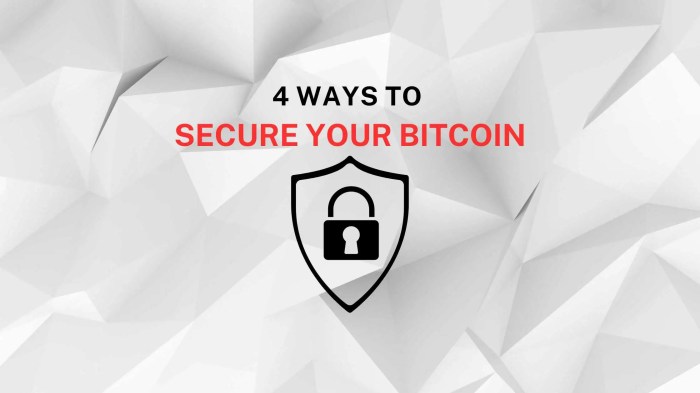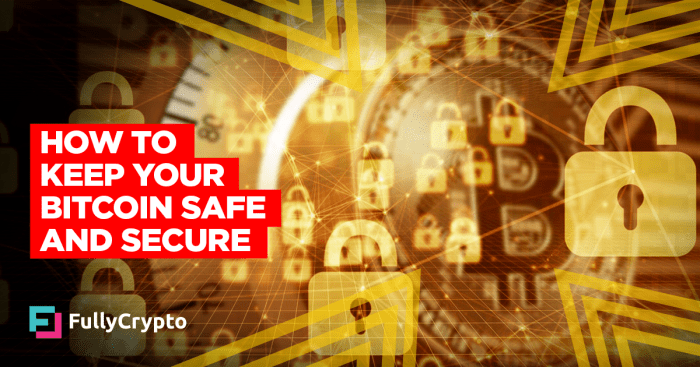Securing your Bitcoin airdrop winnings safely requires vigilance and proactive measures. The allure of free Bitcoin often masks significant risks, from fraudulent schemes to simple security oversights. This guide provides essential steps to navigate the process, ensuring your hard-earned cryptocurrency remains secure.
From verifying the legitimacy of the airdrop itself to choosing the right wallet and implementing robust security practices, we’ll cover the critical aspects of protecting your digital assets. Understanding the differences between legitimate airdrops and scams, as well as the best practices for storing and transferring your Bitcoin, is paramount to avoiding losses.
Verifying Airdrop Legitimacy

The cryptocurrency landscape is rife with opportunities, but also with scams. Bitcoin airdrops, promising free Bitcoin, often attract considerable attention. However, not all airdrops are legitimate. Careful verification is crucial to avoid falling victim to fraudulent schemes designed to steal your cryptocurrency or personal information. Understanding how to identify a genuine airdrop from a scam is essential for protecting your digital assets.Airdrop legitimacy verification requires a multi-faceted approach.
Ignoring even one step can leave you vulnerable. A thorough investigation before participating in any airdrop is the best defense against malicious actors.
Airdrop Legitimacy Checklist
Before engaging with any Bitcoin airdrop, consider these crucial steps:
- Verify the source: Investigate the airdrop’s origin. Is it associated with a reputable cryptocurrency project, company, or exchange? Look for verifiable information and avoid anonymous or untraceable sources.
- Examine the website: Is the website professional and well-designed? Check for secure connections (HTTPS) and examine the website’s “About Us” section for contact information and transparency.
- Check social media presence: Does the airdrop have a significant and active presence on social media platforms? Examine posts for consistent messaging and look for interactions with the community.
- Research the team: Investigate the team behind the airdrop. Are their identities and backgrounds verifiable? A lack of transparency here is a significant red flag.
- Look for whitepapers or detailed documentation: Legitimate airdrops often have detailed documentation outlining the project’s goals, tokenomics, and distribution plan.
- Scrutinize the terms and conditions: Carefully review the terms and conditions associated with the airdrop. Be wary of overly complex or unclear language, or requirements that seem unreasonable.
- Consult community forums: Search for discussions about the airdrop on reputable cryptocurrency forums and communities. Look for warnings or negative feedback.
Red Flags Indicating Fraudulent Airdrops
Several warning signs can indicate a potentially fraudulent airdrop. These should prompt immediate caution and a thorough investigation before proceeding.
- Unrealistic promises: Promises of excessively high returns or guaranteed profits are often indicative of a scam.
- Pressure tactics: A sense of urgency or pressure to act quickly is a major red flag, designed to prevent thorough investigation.
- Requests for private keys: Legitimate airdrops will never ask for your private keys. This is a sure sign of a scam attempting to steal your funds.
- Poorly designed website or unclear information: A website with grammatical errors, broken links, or missing information suggests a lack of professionalism and legitimacy.
- Lack of transparency: A lack of information about the team, project, or distribution plan is a significant warning sign.
- Suspicious links or attachments: Avoid clicking on links or downloading attachments from unknown or untrusted sources, as these may contain malware.
- Requests for personal information beyond what is necessary: Legitimate airdrops rarely require extensive personal information. Be cautious of requests for excessive details.
Methods for Confirming Airdrop Source Legitimacy
Verifying the source and associated website requires diligent investigation. This includes using reputable tools and resources to cross-reference information and ensure its authenticity.
- Use blockchain explorers: Verify the smart contract address associated with the airdrop on a reputable blockchain explorer to check for suspicious activity or unusual transactions.
- Check for official announcements: Look for official announcements from the project or company on their website, blog, or social media channels.
- Verify email addresses and social media accounts: Ensure that the communication channels used for the airdrop are legitimate and belong to the purported source.
- Use website security checkers: Use online tools to check the website’s security certificate and identify any potential vulnerabilities or red flags.
Legitimate vs. Scam Airdrop Characteristics
The following table highlights key differences between legitimate and scam airdrops:
| Feature | Legitimate Airdrop | Scam Airdrop | Explanation |
|---|---|---|---|
| Source | Reputable project or company | Anonymous or unknown source | Legitimate airdrops are usually associated with established projects. |
| Website | Professional, secure (HTTPS), detailed information | Poorly designed, insecure, missing information | A well-designed website suggests legitimacy. |
| Communication | Clear, transparent, and professional | Pressuring, unclear, or uses aggressive tactics | Legitimate airdrops avoid high-pressure sales tactics. |
| Requirements | Reasonable and transparent requirements | Requests for private keys or excessive personal data | Never share your private keys. |
| Promises | Realistic expectations | Unrealistic promises of high returns | Be wary of promises that seem too good to be true. |
| Community | Active and engaged community | Limited or non-existent community engagement | A strong community presence suggests legitimacy. |
Securing Your Bitcoin Wallet: Securing Your Bitcoin Airdrop Winnings Safely

Securing your Bitcoin holdings after receiving an airdrop is paramount. The value of your cryptocurrency is directly tied to the security of your wallet. A compromised wallet can lead to irreversible loss of funds, highlighting the critical need for robust security measures. This section details best practices for securing various types of Bitcoin wallets.
Bitcoin Wallet Types: Advantages and Disadvantages
Choosing the right Bitcoin wallet depends on your technical expertise, security needs, and the amount of Bitcoin you hold. Each type offers a unique balance between convenience and security.
| Wallet Type | Advantages | Disadvantages |
|---|---|---|
| Hardware Wallet | Highest level of security; offline storage protects against online threats; user-friendly interfaces are available for most. | Higher initial cost; requires careful handling to avoid physical damage or loss; can be less convenient for frequent transactions. |
| Software Wallet | Convenient access from various devices; often free or low-cost; some offer advanced features. | Vulnerable to malware and hacking if not properly secured; requires strong security practices, including strong passwords and regular software updates. |
| Paper Wallet | Extremely secure if stored properly; offline and immune to online threats. | Prone to physical damage, loss, or theft; inconvenient for transactions; requires meticulous creation and storage. |
Setting Up a Secure Hardware Wallet: A Step-by-Step Guide
Hardware wallets offer the most robust security for Bitcoin. This guide Artikels the process of setting up a Ledger Nano S Plus, a popular hardware wallet choice, but the principles apply broadly to other reputable brands.
- Purchase and Unboxing: Purchase a Ledger Nano S Plus directly from the Ledger website to avoid counterfeit devices. Carefully inspect the packaging for tamper evidence.
- Device Setup: Connect the device to your computer using the included USB cable. Follow the on-screen instructions to create a PIN code (choose a strong, memorable PIN that is not easily guessable). This PIN is essential for accessing your wallet.
- Recovery Phrase Backup: The device will display a 24-word recovery phrase. This phrase is crucial for restoring access to your funds if your device is lost or damaged. Write it down on paper, store it securely in a safe place, and NEVER store it digitally.
- Wallet Creation: Follow the on-screen prompts to create and secure your Bitcoin wallet on the device. This process involves generating a unique set of public and private keys.
- Software Installation: Install the Ledger Live application on your computer. This application allows you to manage your Bitcoin and other cryptocurrencies.
- Receiving Bitcoin: Once your wallet is set up, you can receive Bitcoin to your unique address displayed on the device and in the Ledger Live application.
The Importance of Strong Passwords and Two-Factor Authentication
Strong passwords and two-factor authentication (2FA) are critical components of a robust security strategy. A strong password should be long, complex, and unique to your Bitcoin wallet. Avoid using easily guessable information such as birthdays or names. 2FA adds an extra layer of security by requiring a second form of verification, such as a code sent to your phone or email, in addition to your password.
Many hardware and software wallets support 2FA. Enabling 2FA significantly reduces the risk of unauthorized access, even if your password is compromised. Consider using a password manager to generate and securely store complex passwords.
Transferring and Storing Your Winnings
Securing your Bitcoin airdrop winnings requires more than just verifying the legitimacy of the airdrop. The crucial next step involves safely transferring your Bitcoin from the airdrop wallet to a secure, long-term storage solution. Failing to do so exposes your digital assets to significant risks, including theft and loss. This process requires careful planning and execution.The transfer of Bitcoin from an airdrop wallet to a more secure storage solution is a multi-step process that prioritizes security.
First, ensure you’ve thoroughly verified the legitimacy of the airdrop and the receiving wallet address. Any errors at this stage can lead to irreversible loss of funds. Once confirmed, initiate the transfer through the airdrop wallet’s interface, carefully double-checking the recipient address before finalizing the transaction. Allow sufficient time for the transaction to confirm on the Bitcoin blockchain; this typically involves several confirmations, depending on network congestion.
Finally, monitor the transaction status to ensure successful completion.
Bitcoin Storage Methods: Security and Convenience Compared
Choosing the right storage method balances security and convenience. Exchanges offer ease of access and trading, but they are vulnerable to hacking and are not truly your own. Online wallets provide more control, but they rely on third-party security and are susceptible to phishing attacks. Hardware wallets, on the other hand, offer the highest level of security by storing your private keys offline.
Paper wallets, while highly secure, require meticulous handling and carry a risk of physical damage or loss. Cold storage methods like hardware and paper wallets significantly reduce the risk of theft compared to online solutions, but they come with a trade-off in terms of accessibility.
Risks of Leaving Bitcoin on Exchanges or in Online Wallets
Leaving Bitcoin on an exchange or in an online wallet exposes your holdings to a multitude of risks. Exchanges have been targets of high-profile hacks, resulting in significant losses for users. Online wallets, while often more secure than exchanges, are still vulnerable to phishing attacks, malware, and vulnerabilities in their software. In both cases, a compromise of the platform’s security can lead to the complete loss of your Bitcoin.
The ease of access these platforms offer comes at the cost of increased security risks. For example, the Mt. Gox exchange collapse in 2014 resulted in the loss of millions of dollars worth of Bitcoin for its users.
Factors to Consider When Choosing a Bitcoin Storage Solution, Securing your Bitcoin airdrop winnings safely
Selecting the right Bitcoin storage solution is a critical decision. Several factors should be carefully considered:
- Security: Prioritize solutions that offer robust security features, such as multi-signature support, strong encryption, and offline storage.
- Convenience: Balance security with ease of access. Consider how often you anticipate needing to access your Bitcoin.
- Cost: Hardware wallets, for example, have upfront costs, while other solutions might have ongoing fees.
- User-friendliness: Choose a solution that is easy to understand and use, regardless of your technical expertise.
- Backup and Recovery: Ensure you have a reliable backup and recovery plan in place in case of hardware failure or loss of access.
- Reputation and Track Record: Research the reputation and track record of the provider, looking for evidence of security breaches or other negative incidents.
Last Word

Successfully navigating the world of Bitcoin airdrops hinges on a combination of due diligence, secure wallet management, and careful transfer procedures. By following the guidelines Artikeld above, you can significantly reduce your risk of falling victim to scams and ensure the safety of your winnings. Remember, a proactive approach to security is the best defense against cryptocurrency loss.
Quick FAQs
What if I receive an airdrop to an unsupported wallet?
Immediately transfer the Bitcoin to a supported and secure wallet. Research the airdrop provider and ensure the receiving wallet is compatible before transferring.
How often should I update my wallet software?
Regularly update your wallet software to benefit from the latest security patches and bug fixes. Check for updates at least monthly.
What are the signs of a phishing attempt related to an airdrop?
Suspicious links, requests for private keys, promises of unrealistically high returns, and communication outside official channels are all red flags indicating a potential phishing scam.
Can I use a paper wallet for long-term storage of my airdrop winnings?
Yes, paper wallets offer strong security for long-term storage, but require meticulous care to prevent loss or damage. Ensure you have multiple backups stored securely.